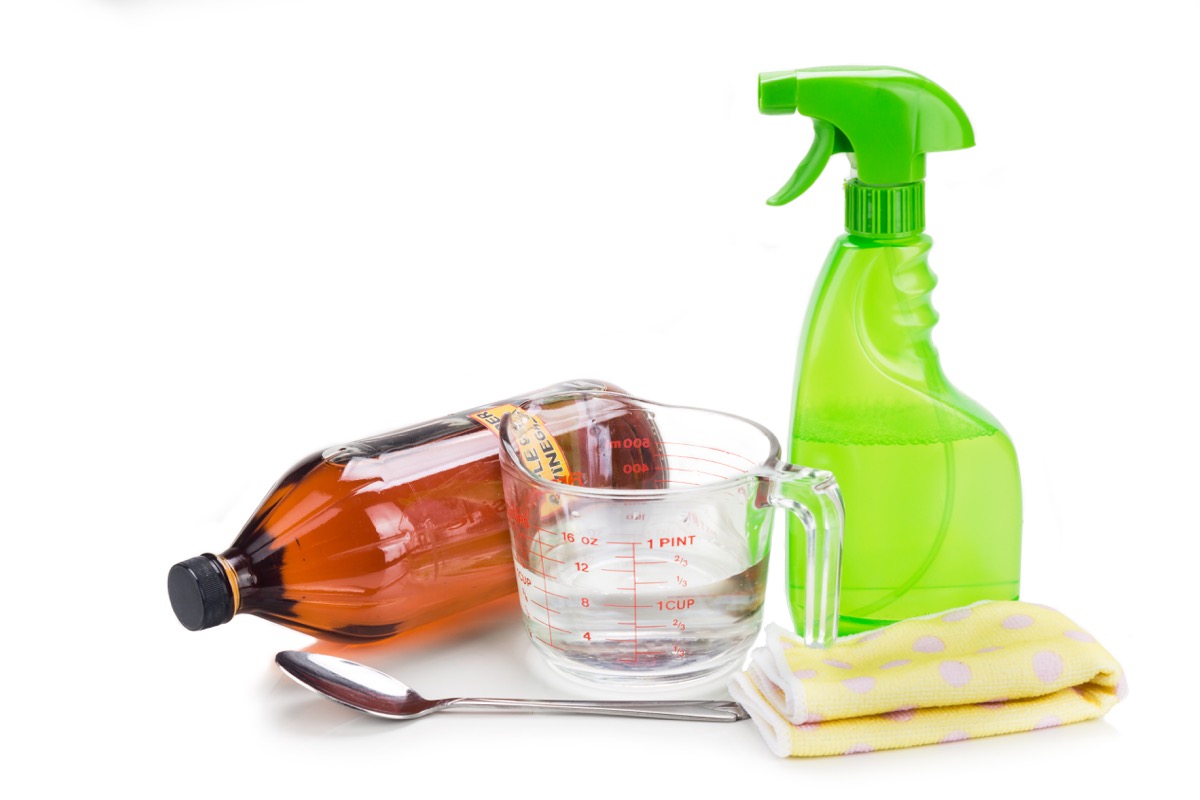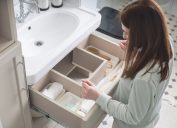How to Clean a Shower Head, According to an Expert
Your bathroom isn't clean until you tackle this overlooked spot.
If you've just cleaned your shower, you're probably reveling in its spic-and-span status. But before you celebrate, look up. Is the shower head clean, too? Or is it a bit dingy and gunky? Shower heads are one of those out-of-sight-out-of-mind places, but since the water that cleans your body passes through here, it can be a pretty bad idea to neglect them. To help figure out the best way to clean this, we reached out to Bailey Carson, head of cleaning at Handy. Keep reading for her all-natural, step-by-step guide on how to clean a shower head.
READ THIS NEXT: What Happens When You Don't Wash Your Sheets Every Week, Doctors Say.
Shower Head Cleaning Supplies

There's no need to spend money on a bunch of supplies to clean your shower head. The best cleaner for this job is one you can make at home.
"Simply combine equal parts water and white vinegar to create an effective yet eco-friendly cleaning solution," Carson says.
Why is vinegar the perfect shower ingredient? Because acetic acid is a solvent that breaks up mineral deposits, which is what builds up in the tiny holes on your shower head.
How to Clean Your Shower Head With Vinegar
Here, we've outlined all the steps you'll need to follow to refresh your shower head. Just don't forget to give yourself a big pat on the back when you're done—or at least take a nice, hot shower.

Remove your shower head.
If your shower head is removable, this is the first step. You may be able to remove it by simply turning the shower head arm counterclockwise. Or, according to Home Depot, you can use pliers or a wrench to do so (though you may want to "place a towel around the shower arm to protect the finish").
Fill a bowl with the cleaning solution.
Once you've removed your shower head, place it into a bowl full of the cleaning solution.
Or fill a plastic bag with the cleaning solution.
If your shower head is not removable, simply place the cleaning solution into a plastic bag and, using a rubber band, tie it around the shower head. If you use this method, it's important to ensure the entire shower head is submerged in the vinegar solution.
Soak your shower head.
Let your shower head soak in the solution for a couple of hours. To allow enough time, you can start the process at night before you go to bed or immediately after the last person in your home takes their daily shower.
Rinse your shower head.
After soaking is complete, start the shower and run hot water for several minutes to flush the shower head and get rid of any excess white vinegar and debris. If you clean your shower head regularly or if it's new, this may be the last step you need to do.

Scrub the shower head.
If your shower head was pretty dirty before you soaked it in vinegar, you may need to add a bit of elbow grease before it's sparkly again. Grab a toothbrush or sponge, dip it in the cleaning solution, and scrub the shower head, taking care to get inside the tiny holes as much as possible.
Dry.
This step is optional, but to get your shower head as shiny as it can be, you can buff it off with a soft, dry cloth after cleaning.
Reattach your shower head.
If you removed your shower head, you'll need to screw it back on. You should be able to use the same method as removing it; just turn in a clockwise motion now.
READ THIS NEXT: What Happens If You Never Clean Your Coffee Maker, Experts Say.
Can I Clean My Shower Head With Bleach?

Bleach can damage bathroom surfaces and fixtures.
You may be wondering why there's been no mention of bleach. And that is because the popular cleaning product can actually do more harm than good to your shower head.
Not only can bleach's corrosive nature damage the metal of your shower head, but it can also eat away at the protective coating of nearby shower tiles and at any caulk around the shower head. Plus, bleach is not effective in removing rust stains.
Bleach can be dangerous.
Bleach can also be harmful to you. "Direct exposure to it can cause burning and irritation to your skin and eyes, or respiratory problems and lung damage if there is a high bleach concentration in the air," Matthew Baratta, VP of Operations at the commercial and industrial cleaning equipment company Daimer Industries, previously shared with Best Life.
For more cleaning advice sent directly to your inbox, sign up for our daily newsletter.
FAQ

How do mineral deposits build up on my shower head?
If you have hard water, you're more likely to get mineral deposits on your shower head. As Wm. Henderson plumbing explains, hard water is categorized as such because it has a large presence of minerals like calcium, magnesium, copper, brass, and iron.
"These elements are absorbed by groundwater as it travels through the soil near your home," the plumbers explain. "While it may not be dangerous to consume hard water, the excess minerals in this type of water will have detrimental effects on your plumbing system."
In terms of your shower head, what you're probably noticing is scale built up from the calcium and magnesium.
How do I know when it's time to clean my shower head?
As cleaning experts shared with Best Life, the five most common signs that you need to clean your shower head are reduced water pressure, uneven spray, strange smells, discolored water, and noticeable buildup.
What happens if I don't clean my shower head?
Not cleaning your shower head when it's dirty can cause all of the functionality issues listed above. It can also be unhealthy, as an unclean shower head may be a breeding ground for bacteria.
Mold and mildew may also be lurking on the shower head, and this can cause cold-like symptoms, allergies, breathing problems, digestive issues, and more.






















